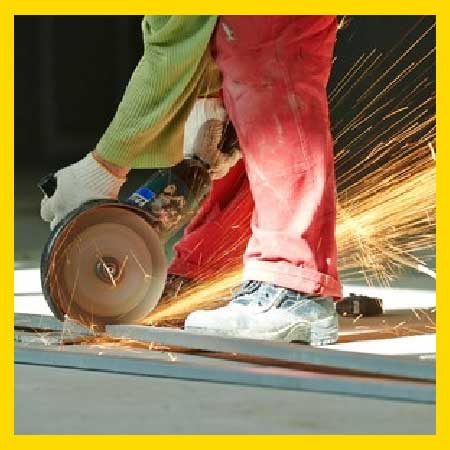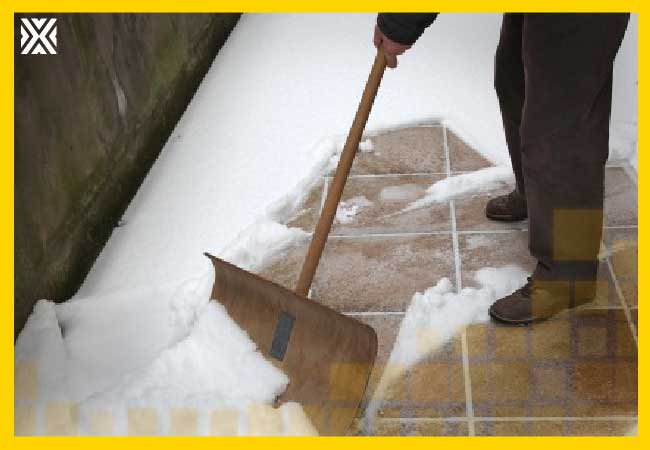Currency
January 02, 2019

Between slippery terrain, wind chill, and precipitation, winter can create an extremely unsafe environment for employees. Feet are often overlooked but are important parts of our bodies we should protect in the winter. Many people do not realize that the feet contain special blood vessels that open up to pass large quantities of blood through them, allowing the body to heat quickly. When we keep our feet warm during the winter months, we can keep our whole body at a more regulated temperature. However, neglecting foot care during the winter leads us to dry, cracked feet or stiff joints.

The snow, ice, and wet sludge often found in piles in the parking lot can be trekked into the workplace, multiplying the number of slippery surfaces and the potential for accidents. In the United States in 2014, there were 42,480 workplace injuries and illnesses involving ice, sleet, or snow, according to the Bureau of Labor Statistics.1 Many of these injuries were slips, trips, and falls that were preventable, had people been more prepared for the conditions at hand (and foot).
Often times, employees may not be educated on the correct footwear to choose to protect them in the workplace. In an office with different roles and responsibilities, it's important each individual knows what tools to look for in order to meet his or her specific foot-care needs. One single corporation can have different employee types: administrative 9-5 workers, active sales teams, and warehouse workers. It's important these employees are not bunched up into one category of winter preparedness. Here are a few tips on how to help employees identify the proper footwear and accessories, based on their role.
In a setting where people are sedentary at their desks for a majority of the day, it's unlikely that these employees require or need heavy-duty traction boots, because they aren't in a setting where they are moving around from one station to another. These employees are more likely to get sore and stiff muscles stemming from cold feet and ankles.
While the walk from the parking lot to the office may be short, this is where they can gather sludge and water onto their shoes, with added wind chills causing their bodies to lose a lot of heat. This cold weather can cause stiff muscles in and around the feet, increasing their chances of slips, trips, and falls on their way into or once they get inside the office. To keep the cold from lingering, investing in warm, wool socks2 will allow heat to be entrapped from the beginning. The key to a good, warm day starts with our feet.
When looking into purchasing winter socks, make sure the fabric consists of at least 50 percent wool fibers—it is the best for naturally absorbing moisture. This not only keeps feet dry in the harshest conditions, but also protects against cold and heat. Investing in a pair that uses double thick yarn, wearers benefit from double the moisture wicking capabilities and ensure the driest possible feet throughout the day. An added bonus would be finding a pair that is anti-microbial to help prevent bacteria buildup, because bacteria can cause several other foot problems.
Sales team members are often on the go—running around from one location to another, gathering lots of snow and sludge on their feet from the outdoors. Due to their constant movement, focusing on shoes with good traction is a top priority. Slippery terrain such as parking lots can greatly increase the chances of falling. Employers are also liable for injuries outside of the workplace, such as parking lots; these can be a hazardous environment that can result in potential injury lawsuits. For this reason, supplying these on-the-go employees with insulated boots and heavy traction is important.
To ensure employee safety, suggest waterproof boots that provide good traction and warmth. The traction is the most important, as it helps to avoid the slips and falls. The outsoles of winter boots are ergonomically designed to grip onto slick surfaces better than your standard work boots and shoes.

The snow, ice, and wet sludge often found in piles in the parking lot can be trekked into the workplace, multiplying the number of slippery surfaces and the potential for accidents. In the United States in 2014, there were 42,480 workplace injuries and illnesses involving ice, sleet, or snow, according to the Bureau of Labor Statistics.1 Many of these injuries were slips, trips, and falls that were preventable, had people been more prepared for the conditions at hand (and foot).
Often times, employees may not be educated on the correct footwear to choose to protect them in the workplace. In an office with different roles and responsibilities, it's important each individual knows what tools to look for in order to meet his or her specific foot-care needs. One single corporation can have different employee types: administrative 9-5 workers, active sales teams, and warehouse workers. It's important these employees are not bunched up into one category of winter preparedness. Here are a few tips on how to help employees identify the proper footwear and accessories, based on their role.
Administrative
In a setting where people are sedentary at their desks for a majority of the day, it's unlikely that these employees require or need heavy-duty traction boots, because they aren't in a setting where they are moving around from one station to another. These employees are more likely to get sore and stiff muscles stemming from cold feet and ankles.
While the walk from the parking lot to the office may be short, this is where they can gather sludge and water onto their shoes, with added wind chills causing their bodies to lose a lot of heat. This cold weather can cause stiff muscles in and around the feet, increasing their chances of slips, trips, and falls on their way into or once they get inside the office. To keep the cold from lingering, investing in warm, wool socks2 will allow heat to be entrapped from the beginning. The key to a good, warm day starts with our feet.
When looking into purchasing winter socks, make sure the fabric consists of at least 50 percent wool fibers—it is the best for naturally absorbing moisture. This not only keeps feet dry in the harshest conditions, but also protects against cold and heat. Investing in a pair that uses double thick yarn, wearers benefit from double the moisture wicking capabilities and ensure the driest possible feet throughout the day. An added bonus would be finding a pair that is anti-microbial to help prevent bacteria buildup, because bacteria can cause several other foot problems.
Sales Team
Sales team members are often on the go—running around from one location to another, gathering lots of snow and sludge on their feet from the outdoors. Due to their constant movement, focusing on shoes with good traction is a top priority. Slippery terrain such as parking lots can greatly increase the chances of falling. Employers are also liable for injuries outside of the workplace, such as parking lots; these can be a hazardous environment that can result in potential injury lawsuits. For this reason, supplying these on-the-go employees with insulated boots and heavy traction is important.
To ensure employee safety, suggest waterproof boots that provide good traction and warmth. The traction is the most important, as it helps to avoid the slips and falls. The outsoles of winter boots are ergonomically designed to grip onto slick surfaces better than your standard work boots and shoes.









